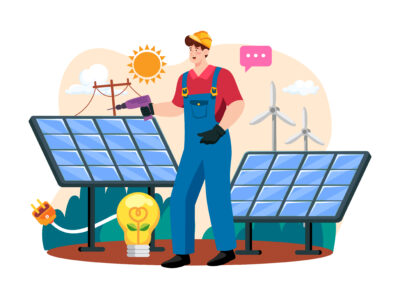Renewable energy to offer large-scale employment in India

Green job chronicles: unveiling India’s sustainable job revolution
April 20, 2024
What’s trending in employer branding for 2024
April 20, 2024
If you are a true-blue Bengalurean, you would have, for sure, realised the tremendous changes in the weather and climate over the last couple of decades. Last year, the city witnessed a drab monsoon while spring and summer saw the early-blooming of faux cherry blossoms (as we like to call them), apparently owing to higher temperatures. And, this is not just true for Bengaluru but for the rest of the world too. The waves of the pandemic, global economic and geopolitical instability, extreme weather events and climate disasters have underscored the need to prioritise climate change and its severe effects. In India, sustainable development has become one of the key priorities and the country has emerged as a frontrunner in battling climate change. Consider this: India constitutes more than 17% of the global population, and yet the cumulative greenhouse gas emission between 1850 and 2019 is just 4%, while the per capita annual emissions constitute just one third of the global average.
Factors driving the renewable energy sector
India’s efforts to address climate change are a mix of short-term and long-term initiatives. These include domestic commitments as well as taking the lead and collaborating with international organisations. At the Conference of Parties 2026 (COP26), India made a commitment to achieve net zero carbon emissions by 2070, with a long-term low-carbon development strategy (LT-LEDS). This transition is planned with low-carbon development of electricity systems and low-carbon transport and industrial systems, amongst other green initiatives.
India has committed to a 50% share of renewables for the generation of electricity by 2030. The government of India has also launched the International Solar Alliance (ISA), an international coalition to increase the use of solar energy in member countries by sharing resources. India’s recently concluded presidency of G20 centred on sustainability and inclusivity.
The recent Union Budget for 2024–25 has sustainable development as one of the strategies for Amrit Kaal, the vision for New India by 2047. To fulfil the commitment towards net zero by 2070, the budget supports funding and financial assistance for the renewable energy sector. The electric vehicle (EV) sector is set to be strengthened as well, with the adoption of e-buses for public networks and supporting manufacturing and charging for EVs.
India’s renewable energy ambitions are expected to generate massive employment opportunities in the solar and wind energy sector. By 2030, the clean energy sector is estimated to generate over 3.4 million jobs for over a million people. The renewable energy space is poised to become a major hub for employment. Let us see how.
The green job boom
The wind and solar energy sector already employs more than 100,000 people. According to Dr. Arunabha Ghosh, CEO, Council on Energy, Environment and Water (CEEW), the ambitious renewable energy targets provide opportunities to deliver jobs, growth and sustainability while, at the same time, enabling a transition to a low-carbon economy.
There is a heightened focus on training and skilling for green energy jobs. Environmental awareness is being integrated into job training by the Skills Council for Green Jobs (SCGJ). India has the advantage of being a youthful country. Promoting rural skill development programmes will increase the employability of local youth. Renewable energy jobs also have the potential to be more equitable, allowing for more women to participate. For instance, the grassroots level programme Hariyali Gram focusses on green initiatives in villages and drives livelihood opportunities for women in villages.
Across the world, too, clean energy jobs have overtaken traditional jobs in the fossil fuel sector. According to the World Energy Employment Report 2023, clean energy jobs are ahead of fossil fuel jobs and are growing 3.6 times more than the latter. In terms of the number of clean energy jobs being created, India stands fourth in the world.
Advances and continuous innovation in technology are adding to the growth of the sector as well. For instance, battery energy storage systems and the green hydrogen sector will increase employment opportunities.
With green growth being a high priority for India, the renewable energy space offers high potential for large-scale employment in India. To develop a highly skilled workforce, universities should offer mainstream industry-relevant courses; government agencies need to develop skilling programmes to train the local population. Creating gender-focussed training programmes can improve the participation of rural women. The renewable energy sector offers a great opportunity for the government to achieve sustainable development goals, move towards energy independence and generate employment.


